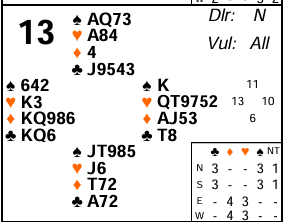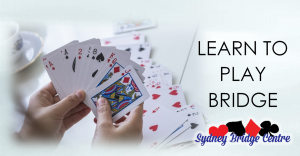City and Canada Bay – Thursday Morning 9th January 2025.

Board 13 last week was a competitive partscore hand where, defending on how the play goes, declarer may be able to make a valuable inference.
Many players these days will open North with 1♣. Although there are only 11 points, the 5431 shape is always attractive.
East will overcall 1♥ and South will show spades. It’s common to play here that a bid of 1♠ shows at least 5 spades and a double shows exactly 4 spades. That’s quite helpful to more quickly identify if there is a spade fit although there are other treatments (see advanced section for more).
After that West, who has the best hand at the table, will clearly also get involved. He has a perfect hand for a competitive double – showing some values but no clear bid himself. Such a hand usually holds the unbid suit (diamonds) and tolerance, but not direct support, for partner’s suit (almost always a doubleton). North will no doubt raise spades and it becomes a case of how high each side is willing to go! As is so often the case, both sides can make 9 tricks but neither can make game – although one or two pairs were allowed to do so.
A common contract was 3♥ by East. After ♠J lead, North will win and has a choice of defences. If he continues spades then declarer will ruff and naturally lead a heart to the ♥K and ♥A. It’s then highly likely declarer will lose another trump as he will finesse into South’s now singleton ♥J. Along with the two black aces that is 4 losers and 9 tricks in all. Alternatively at trick two North might switch to his singleton diamond. Once he gets in with ♥A, he can cross to partner’s ♣A to receive a diamond ruff. That definitely gets the defence 4 tricks but this time gives them a chance for another trick – see advanced section.
Where North South compete further in spades, West will most likely lead the ♥K. Declarer may well cross to hand with ♣A to take the spade finesse which will lose to the singleton ♠K. Another thing he might try is to duck the ♥K, win the next heart, in the hope of then trumping a heart to hand. Or, similarly, win ♥A and play one back towards his ♥J. That plan will work but, if it does, it is somewhat ironic as declarer has successfully reached his own hand but should now definitely NOT take the spade finesse! Can you see why? See advanced section for more.
Key points to note
5431 shapes usually play well and it’s worth bidding a bit more aggressively with them.
A competitive double is a useful bidding tool – after partner has overcalled and both opponents have bid it typically shows some values but no clear bid (so typically the unbid suit and tolerance for partner’s suit).
If a defender has a chance to over-ruff and doesn’t do so, it usually means the relevant trump cards must be in his partner’s hand. That can sometimes enable declarer to drop a singleton honour offside that he otherwise might not have been able to do.
More advanced
After 1 minor and a 1 heart overcall there are two basic treatments. One is as I described above – 1♠ shows at least 5 spades and double shows exactly 4. Another treatment is to play 1♠ as 4+ spades and double to be a hand with fewer than 4 spades but some values that would like to compete. I tried playing that for a while with my regular partner but we found it hardly ever came up and it was more useful to be able to immediately distinguish the spade length. So we went back to 1♠ being 5+ and double being 4.
When playing in hearts the trump suit is very hard to get right (you need to run ♥10). The natural play is low to the K and A and then to finesse again losing, unluckily, to South’s now singleton ♥J. Even if the defence have found their diamond ruff, it’s still a guess for declarer when he leads the 2nd heart from West and North plays the ♥8. Is the layout like this or did North start with 4 hearts originally? It’s not clear – North could be 4414 or 3415 shape. The only clue that might help get it right is now keenly North raised spades in the auction – if he only had 3 card support he might not be willing to compete as high. If he has 4 spades then he is less likely to also have 4 hearts.
Switching now to considering a spade contract by South on ♥K lead. If declarer does duck, win the next heart and then ruff a heart to hand it will win the trick and West will discard. When West can’t overruff declarer should infer that East must have the ♠K and hence the only chance is to play for it singleton offside – which works. Alternatively suppose declarer won ♥A immediately and played a 2nd one towards his ♥J. When East wins ♥Q he is in a no-win scenario. His natural play is to play a 3rd heart (after all from East’s point of view his partner might have the ♠J). As above, West’s inability to overruff means the ♠K can then be placed with East. But, equally, suppose East switches to something else then an alert declarer should ask himself the question about why did East NOT play another heart?! The only reason is that he knows his partner doesn’t have ♠K. East is damned if he does play another heart, and damned if he doesn’t!
Julian Foster (many times NSW representative) ♣♦♥♠



